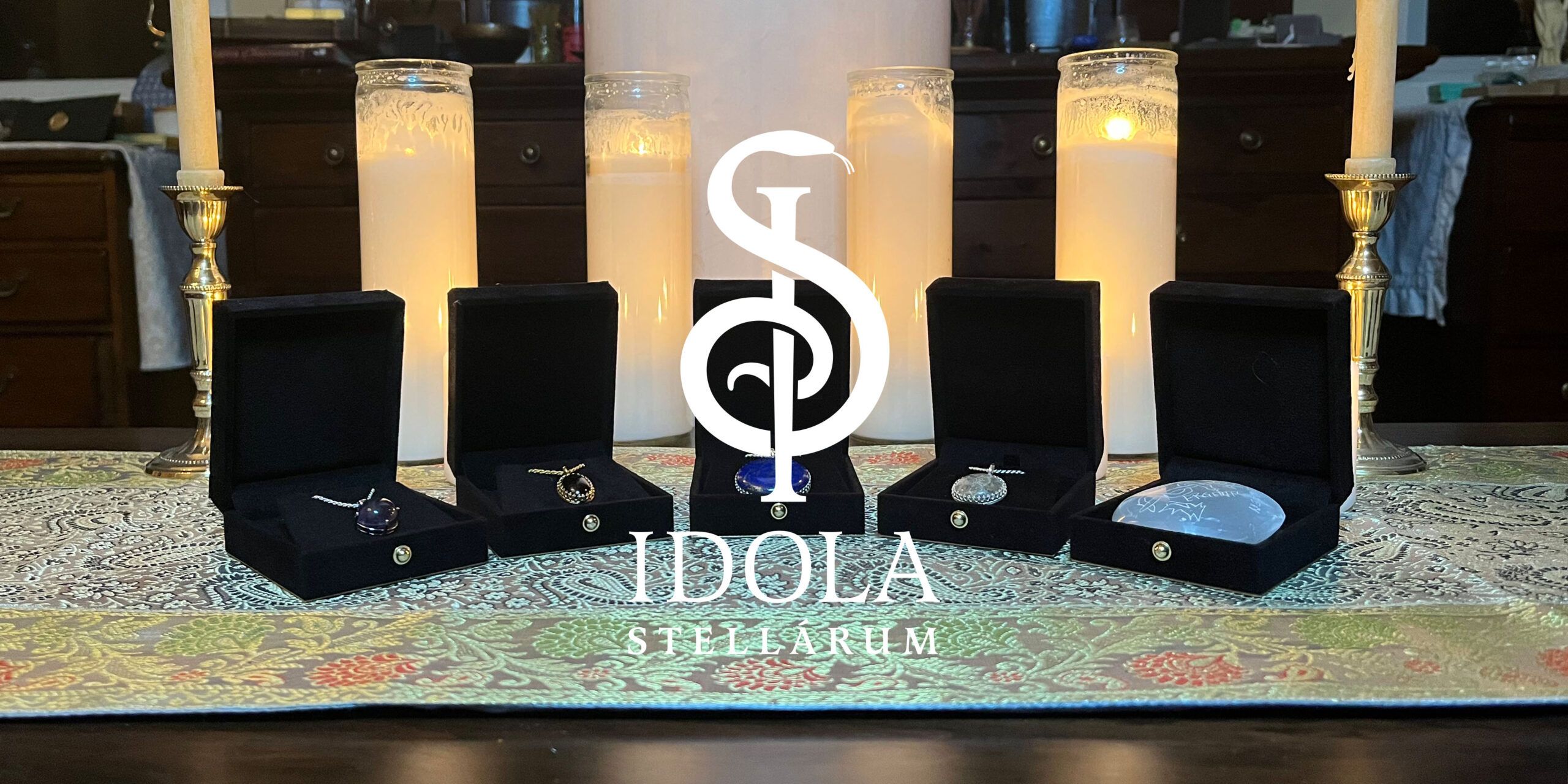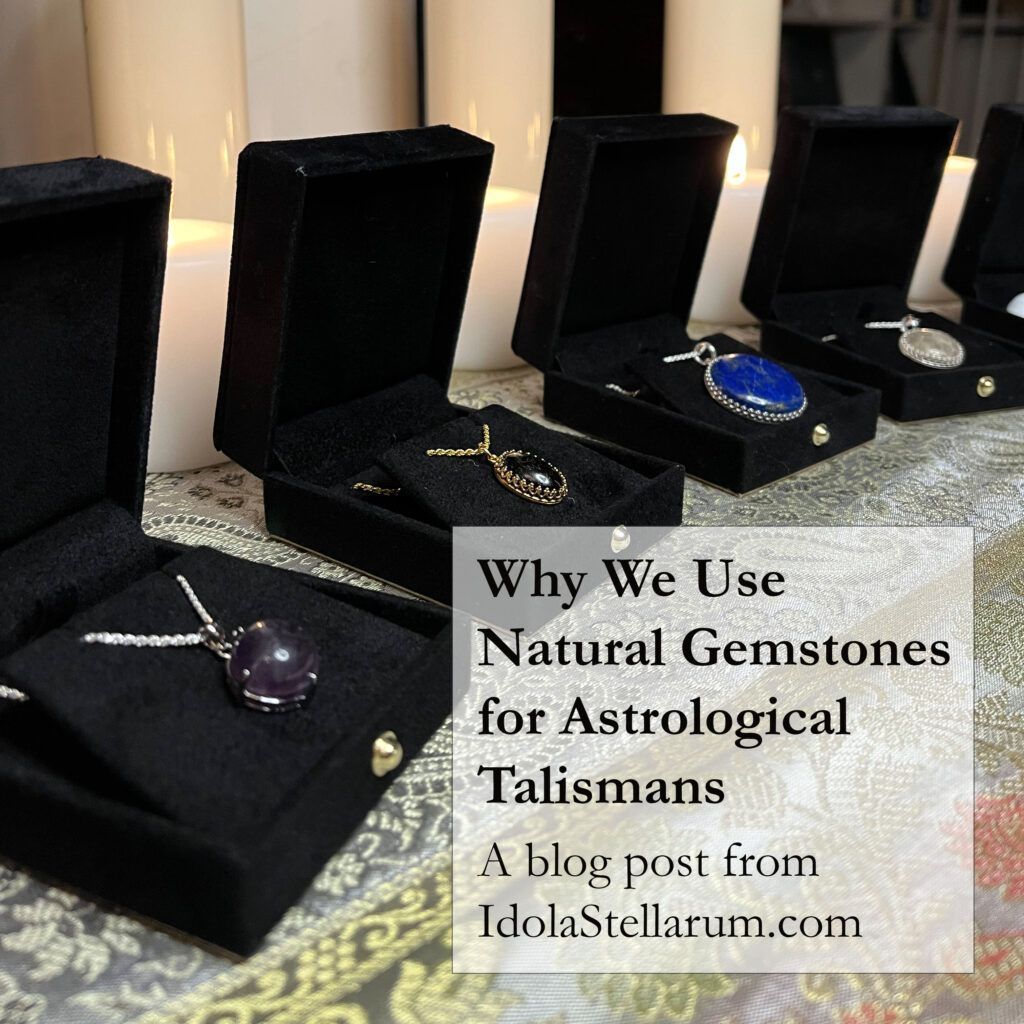Your cart is currently empty!

Why We Use Natural Gemstones for Astrological Talismans
At Idola Stellarum, we make every effort to source gemstones that are 100% natural: undyed, unheated, untreated, and not lab-created. We are painfully aware that natural gemstones present their own violence and ethical problems, including but not limited to the opacity of the supply chain, the treatment of workers, disrespect for the land and Indigenous peoples, the environmental and social impacts of mining. There is no substitute in this particular tradition of magic for using specific natural materials with affinities specific to the celestial entities petitioned in specific elections. We encourage and experiment ourselves with magical innovations focused on more ethically available and locally sourced materials, which hopefully you’ll see the fruits of in the future, but as you’ll see in our early collection releases, our public releases are created mostly by-the-book(s).
In a previous post, we examined why materials matter in astrological magic, and established how our careful attention to the ingredients of astrological talismans constitutes a kind of co-participatory prayer with the matter that forms the basis of talismans. Here, we further dig into why we focus on natural gemstones in particular.
Gemstones and Metals are Central to the Tradition of Astrological Magic
Materials matter in magic generally, and materials matter in astrological magic in particular. Even a cursory glimpse at the core source texts of the tradition will reveal an emphasis, if not a preoccupation, with the ingredients of talismans.
The Picatrix, for example, contains one of, if not the premiere, recipe list for crafting astrological talismans in Book II, Chapter 2, which begins with the author’s intention statement for the chapter: “to reveal how each planet corresponds to metals and stones, and to the figures of the planets and their marvelous operations.” The chapter makes absolutely clear that specific magical purposes and intentions come to fruition through the harmonious correspondence between specific celestial images, specific celestial entities, and specific materials.
The medieval and Renaissance worldview of astrological magic understands reality as an orderly chain of being, with qualities of the higher spheres of existence reflected and emanated down through the lower spheres. The rarified, upper sphere of the fixed stars therefore can be seen as a kind of template for understanding the spheres below.
In our primary sources for fixed star talismans, there is a clear, unbroken link between specific fixed stars and specific gemstones in particular. In the oldest version of De Quindecim Stellis, the author first outlines the general nature of the 15 Behenian fixed stars, before going on:
“…to reveal the splendor and power which the Most High himself hath enclosed in precious stones, whose virtues are assimilated to the virtues of the aforesaid stars.”
—Quadripertitus: The Fourfold Book of Hermes, De Quindecim Stellis, tr. Regulus Hess
John Gower, in his 1393 text Confessio Amantis (one of the many derivatives of De Quindecim Stellis), writes: “Of certain stars [and] what they mean; Of which…there be fifteen, and sundry to every one a grass [herb] belongeth and a [gem]stone, whereof men work many a wonder” (tr. Regulus Hess). If principles of specific correspondences belong to the sphere of the fixed stars, we should expect this principle to apply to the spheres below as well.
And indeed, with one notable exception which we mention below, astrological magic source texts center specific gemstones and metals as key ingredients in talismanic recipes. The planetary talismans of the Picatrix; the Astromagia Lunar Mansion talismans of the Zodiologion of Kankaf the Hindu, the Zodiologion of Pliny, and the Zodiologion of the Hindus; the fixed star talismans from the various versions of De Quindecim Stellis; the planetary sigils of Israel Hibner’s Mysterium Sigillorum—all refer to specific stones and/or metals (with some occasional references to wax figures).
To quote one among many sources, the Picatrix description of the images of the faces (decans) of the signs states:
“When you make any of the images of the faces described above, make them in a material appropriate to the planet that rules the face.”
—Picatrix, Book II, Ch. 11, tr. John Michael Green & Christopher Warnock
The ubiquity of such instructions is unmistakable.
But why gemstones and metals? Just as a figure drawn in the dirt or sand quickly becomes erased by a strong wind or the first rain, and just as words written on a leaf will in short order decay and crumble, not all materials hold a charge, so to speak. The more dispersible qualities of certain materials, such as sand or a leaf, are essential to their magical participation. Such is the same with more lasting materials. Marsilio Ficino underscores the enduring qualities of harder materials:
“[G]ems and metals, although they seem too hard for accepting a celestial influence, nevertheless retain it longer if they receive it, as Iamblichus confirms. That is to say, by their hardness they also retain the vestiges and gifts of the life of the world, which they had once possessed while embedded in the earth, for a very long time after being rooted out.”
—Marsilio Ficino, Three Books on Life, Book III, Ch. XIII
He later emphasizes the preciousness of gemstones and metals, and their history as generated in the deep of the earth through the actions of celestial rays, as further reasons for their fitness as materials for astrological talismans:
“But lest we wander too far afield, let us now conclude that if the rays of the stars quickly penetrate the whole earth, it cannot easily be denied that they quickly penetrate metal and precious stone when they are engraved with images, and imprint in them wonderful gifts, or at least gifts of some kind, since indeed they generate supremely precious things in the womb of the earth.”
—Marsilio Ficino, Three Books on Life, Book III, Ch. XVI
Why One Might Prefer Gemstones
Our personal aesthetic preferences and technical skills push us in the direction of gemstones rather than metal, but there are other more general reasons why one might prefer gemstone talismans to metal.
One advantage of metal is that it is amenable to casting and stamping of complex images, which can look stunning as talismanic jewelry. Right now, with Neptune in Pisces, the aesthetics of witchcraft and the occult have become commonplace, even mainstream, and so there is greater appeal in wearing incredible, artistically rendered occult images cast in metal, such as those offered by Christopher Warnock, Genie Desert, and Tony Mack, all exceptional talismanic mages. However, in many times and places, openly pronouncing one’s interest in the occult would have been and could still be quite dangerous.
There is no guarantee that the culture at large where we operate will remain tolerant of people openly emblazoning themselves with symbols of the occult. Moreover, openly advertising your intent and action to influence others and the world around you through talismanic spirits in the form of impressive magical jewelry can affect how people consciously regard and approach you, which may or may not be what you are going for.
In contrast, wearing an engraved gemstone does not necessarily attract the same attention in less-than-amenable environments. This is exactly why some won’t appreciate them and of course that’s valid, but talismanic jewelry made from engraved gemstones can blend in a little more easily which makes it potentially supportive and accessible for those who need that. Engraved gemstone talismans can be camouflaged as or among mundane jewelry, especially given that the carvings usually cannot be noticed, let alone identified, unless someone takes a very close look.
Why Must Gemstone Talismanic Jewelry Use Natural Gemstones?
The eminent astrological magician Clifford Low has made the case in a number of venues that experience and theory caution against engraving unnatural gemstones for talismanic purposes—that is, gemstones that were lab created, or originally natural stones that have been treated (e.g., heated, color-enhanced, dyed, etc.). With respect to gemstone treatment, Low has argued that these processes can be akin to killing a creature.
Within a spirit model, a gemstone is not inert matter, but alive. Applying extreme temperatures to it or filling it with artificial dyes may harm it and hinder how effective it could be as a talisman, just as a horse in a heatwave could be impossible or inadvisable to ride, and a bird covered in oil makes it difficult to impossible for them to fly.
Similarly, we have no guarantee that a lab-created emerald has the same kind or quality of spirit as one that crystallized slowly over eons beneath the earth. A quotation from Marsilio Ficino provides some grounds for reflection:
“Also, it is probable…that things so beautiful [as gemstones and precious metals] cannot be fused under the earth without a consummate effort of the heavens, and that the power impressed in them once and for all from that effort remains. For the heavens have labored an immense length of time in concocting and assembling these things.”
—Marsilio Ficino, Three Books on Life, Book III, Ch. XIII
Perhaps there are some interesting arguments that could be made about artificial materials. Perhaps some postmodern magician will write a tract, a la Walter Benjamin, on ‘Astrological Talismans in the Age of Mechanical Reproduction.’ For us, however, oriented as we are to the interrelatedness of the sublunary realm with the cosmos, we take a different perspective grounded in the deep time rhythms of development.
Astrology as a discipline foundationally attends to the rhythms and qualities of time. Psychology as a discipline understands that human development takes time. Just as one cannot bake a cake twice as fast but equally well by doubling the temperature, just as one cannot get twice as much similar enjoyment from a symphony by listening to it at twice (or half) the speed, and just as one does not get the same satisfaction from being airlifted to the mountain summit as when one makes the journey oneself, creation cannot be hurried.
Every single natural thing that exists in the world requires a consummate effort of the heavens, and for the heavens to labor an immense length of time to instill them with their spirit and quintessence. Using natural materials, in addition to very likely being simply more efficacious from a magical perspective, also respects the efforts of the celestial agents.
Prioritizing natural materials also supports innovative mages including the participation of materials from their local environment in astrological magic. We do not equate ‘unattested in books’ with ‘invalid in entirety.’ The books themselves, as an important piece of the history of the codex and written word, are rife with the violence and erasure of colonialism and imperialism. They also incompletely represent the universe of natural gemstones, many of which were not known or documented by the peoples and cultures who produced the texts in our magical tradition.
Being clear with our customers and clients about our practices is a commitment to transparency and integrity so they can make informed choices about the talismans they relate with. We acknowledge that many current mining practices have grievous impacts, as do most industries under late capitalism. Given that we see no substitute for natural materials, we do our best to source conscientiously, understand our impact, and to charitably contribute to organizations that seek to remediate and offset industrial and social harms enacted on the Earth.
As stewards of the tradition of astrological magic, it is our privilege to bring the wonder of astrological talismans to others. Sign up to our mailing list for word of our upcoming talismanic collections and workings:
By clicking ‘subscribe’, I consent to Idola Stellarum storing my email and information solely for the purpose of communicating upcoming offerings and content, and I am able to unsubscribe at anytime.

